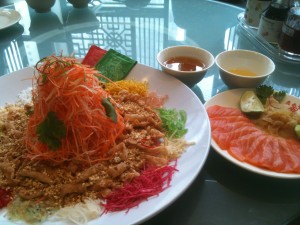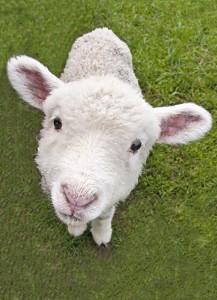-

Yu Sheng, the salad that Malaysian Chinese toss to ensure prosperity for the coming year. Photo by Jade Chan.
Today (as I write this) is Chinese New Year’s Eve, celebrated by Chinese all over the world. February 19 marks the beginning of the lunar New Year, which then continues for 15 days of festivities.
This is the Year of the Goat – or Ram, or Sheep, depending on the source, and perhaps where you live. One theory has it that if you live in a country with more goats, you’re more likely to call it the Year of the Goat. If sheep are more common, then you’re more likely to call it the Year of the Sheep or Ram.
For instance, in the U.S. it’s more commonly called The Year of the Sheep or Ram, while in goat-loving France it’s the Year of the Goat.
In any event, the Chinese character (“yang”) for the goat and sheep are the same, even though the animals themselves are somewhat different. Yang is then modified by other characters to indicate what the exact animal is.
Yang has an auspicious connotation, so those born under it’s zodiac sign are probably calm and gentle, according to Chinese astrology. (The Chinese zodiac consists of 12 animals, real or mythological, such as horse, dog, rat, dragon, etc., which rotate over the course of a dozen years.)
What’s to Eat?
It occurred to me that it might be appropriate to serve lamb to mark the Year of the Sheep, so I checked in with my friend Jade Chan, who is part of Malaysia’s large ethnic Chinese community.
She quickly set me straight (which was good, because what would I serve during the year of the dog, dragon, or rat?).
“For Chinese New Year,” she told me, “some of the traditional ingredients are prawn, fish, abalone, oyster, black moss, and nian gao (a sticky cake).”
It’s all about the symbolism, she continued — “auspicious connotations for the year ahead.” The symbolism is based on similar sounds (homophones) in Mandarin and Cantonese.
For example, “Prawn (大虾) is called ‘ha‘ in Cantonese and it sounds like laughter, so its symbolism is like happiness.”
Fish, in turn, stand for abundance. Fish (鱼) is called “yu” in Mandarin, and is pronounced the same as the Chinese word for abundance or surplus (余).
So when the Chinese say “nian nian you yu” (年年有余), it means “may there be abundance (or ample surplus) every year” – to better prepare for the next year.
Similarly, abalone stand for good fortune, oysters for good news, and sea moss and Nian gao for prosperity.
In Malaysia and Singapore, Jade told me, it’s common to start New Year’s meals with a dish called “yu sheng” — a raw salad topped with fish, usually salmon.
“If served at a restaurant, the server will pour the seasoning and sauces and add the salmon, while saying auspicious phrases like ‘nian nian you yu’ and ‘bu bu gau sheng.’ After that, everyone tosses the yu sheng as though you would a mixed salad. Except it’s much messier with yu sheng because everyone tosses it together, and you’re supposed to toss it as high as possible.”
The higher you toss, she said, the better the year ahead.
Chinese New Year is a time for families to gather from near and far — the New Year’s Eve feast is often called the reunion dinner — and to invite neighbors in as well.
The feast is typically served in the center of a big round table, and everyone digs in to the various dishes with their chopsticks. The oldest people at the table and guests get first dibs.
New Year Greetings and Rituals
When I lived in San Francisco, the most common New Year’s greeting was “Gung Hay Fat Choy,” which is Cantonese and translates roughly like “congratulations on being prosperous” or “wishing you prosperity.” The Mandarin version, which is actually more common in China, is Gong Xi Fa Cai. While written the same way in Chinese and having similar meaning, the two phrases are pronounced somewhat differently.
If you actually want to say “Happy New Year,” Jade told me, the proper Mandarin greeting is “Xin nian kuai le.”
In the days leading up to Chinese New Year, the Chinese consider it important to pay off their debts and start with a clean slate.
In Jade’s case, she was cleaning her room, which is considered auspicious for the year ahead. It’s much like the concept of spring cleaning, because Chinese New Year is also known as the Spring Festival.(If it doesn’t feel quite like spring yet where you live, consider that 2015’s is actually one of the later dates for Chinese New Year, which is based on the lunar calendar and may fall at any time from around January 20 to February 20.)
However, Jade cautioned, “cleaning your house on the actual date of Chinese New Year is considered bad luck – it’s like sweeping your good fortune away for the coming year.”
It’s traditional for parents and any older or married members of a family to give red envelopes (hong bao) filled with money to children and unmarried family members. The packets are given as a sign of good luck and prosperity. “The amount doesn’t matter so much,” Jade said, “except for many Chinese it’s essential to avoid anything featuring the number four, which means death (sei) in Cantonese.”
And if the appropriate dishes are served, the house is clean, the debts are paid off, and the number four is avoided, the following year is bound to be a good one!
Gong Xi Fa Cai!















Leave a Reply